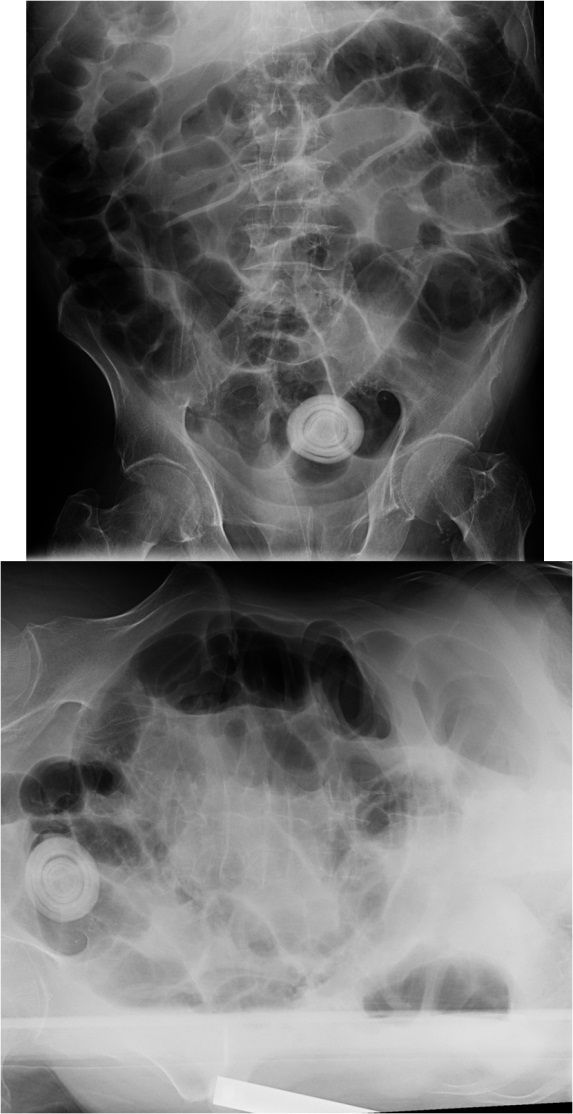Gallbladder Ileus
Three cases: A 98-year-old male with multiple co-morbidities presented with abdominal pain, fever and distension; Elderly female patient with right upper quadrant pain; A 50-year-old female with acute abdominal pain, r/o obstruction.
First case: A 98-year-old male with multiple co-morbidities presented with abdominal pain, fever and distension, r/o free air.

X-ray of the abdomen: Supine and sitting; Lamellated relatively large opacity in pelvis with dilated small and large bowel indicating obstruction, most likely from gallstone ileus with gallbladder stone in distal left colon.

Ultrasound: Gallbladder is not well distended and shows irregular outline. Multiple hypoechoiec lesions in liver, likely metastasis, for further work-up.

CT scan of abdomen and pelvis done without contrast for intestinal obstruction, as patient had high creatinine.
Findings:
CT abdomen without contrast, shows collapse gallbladder with air in IHBR with stone in sigmoid. Thickening of sigmoid beyond stone, worrisome for malignancy. Liver lesions seen by ultrasound, cannot be evaluated without contrast. Bilateral pleural effusion, Rt>LT. Patient lost follow-up.
Second case: Elderly female patient with right upper quadrant pain.

First plain film:Radio density in right upper quadrant, most likely due to gallstone. No signs of bowel obstruction.

Second film after one year with acute presentation: Previously seen density in right upper quadrant is not seen and opacity noted pelvis with distal small bowel obstruction and air in IHBR indicating Rigler’s triad from gallbladder stone ileus.

CT of the abdomen and pelvis: Coronal reconstruction; Confirms the findings of gallstone ileus.
Third case: A 50-year-old female with acute abdominal pain, r/o obstruction.

Plain film: Multiple dilated small bowel air-fluid level, air in IHBR, fain opacity left side of L-L4 (shown by arrow), indicating gallbladder stone ileus (Rigler’s triad).

CT confirms the findings of plain films and it is consistent with gallstone ileus.

Coronal reconstruction of CT abdomen shows gallstone ileus and it is in proximal ileal loop.
Discussion:
Gallbladder stone ileus is an unusual complication of chronic cholecystitis, impaction of gallstone in ileum after passing through a biliary-enteric fistula. Sixty percent are cholecystoduodenal fistulae; others are cholecystocolonic and cholecystogastric fistulae. The average age of the patient is 70; there is a delay in diagnosis and a mortality of 15 percent to 20 percent.
Strong clinical suspicion, timely use of combined diagnostic imaging modalities (mainly, abdominal plain film and CT scan) and early surgical intervention are of paramount importance to achieve a favorable outcome. It accounts for 10 percent of obstruction in those over 65 and accounts for 25 percent of obstruction in the elderly. It is more common in females. It forms part of the Bouveret syndrome (when obstruction occurs in the duodenum).
Recurrence rate is 5 percent to 10 percent, and 40 percent present with pneumobilia. Stones over 2.5 cm will cause obstruction. Mortality rates are high and surgical intervention is required. Small bowel obstruction can lead to thiamine deficiency which may result in Wernicke's encephalopathy.
Rigler's triad, which should not be confused with Rigler’s sign, consists of three findings seen in gallstone ileus:
• pneumobilia
• small bowel obstruction
• gallstone, usually in the right iliac fossa
Differential Diagnosis:
• The differential is essentially that of each component of Rigler's triad.
• Lower abdominal/pelvic calcification
• Small bowel obstruction (other causes)
• Pneumobilia
Sushila Ladumor, MD, FRCR, consultant radiologist with multi-modality imaging experience, working in Medical Imaging Department, King Abdulaziz Medical City, Riyadh, Saudi Arabia.
References:
http://www.patient.co.uk/doctor/Gallstone-Ileus.htmhttp://www.uptodate.com/contents/gallstone-ileushttp://www.isrjem.org/april%202009.caglayan-gallstoneileus.pdf
Newsletter
Stay at the forefront of radiology with the Diagnostic Imaging newsletter, delivering the latest news, clinical insights, and imaging advancements for today’s radiologists.